engine oil PONTIAC BONNEVILLE 1997 Owner's Manual
[x] Cancel search | Manufacturer: PONTIAC, Model Year: 1997, Model line: BONNEVILLE, Model: PONTIAC BONNEVILLE 1997Pages: 405, PDF Size: 18.83 MB
Page 274 of 405
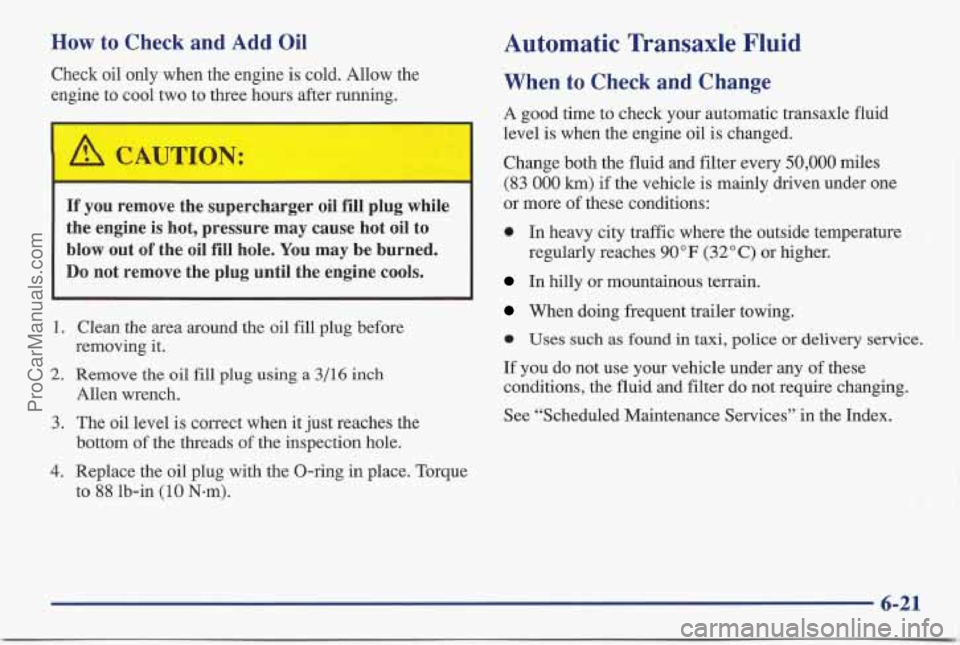
How to Check and Add Oil
Check oil only when the engine is cold. Allow the
engine to cool two to three hours after running.
If you remove the supercharger oil fill plug while
the engine
is hot, pressure may cause hot oil to
blow out
of the oil fill hole. You may be burned.
Do not remove the plug until the engine cools.
1. Clean the area around the oil fill plug before
removing it.
2. Remove the oil fill plug using a 3/16 inch
Allen wrench.
3. The oil level is correct when it just reaches the
bottom
of the threads of the inspection hole.
4. Replace the oil plug with the O-ring in place. Torque
to
88 lb-in (10 N-m).
Automatic Transaxle Fluid
When to Check and Change
A good time to check your autamatic transaxle fluid
level is when the engine
oil is changed.
Change both the fluid and filter every
50,000 miles
(83 000 km) if the vehicle is mainly driven under one
or more of these conditions:
0 In heavy city traffic where the outside temperature
regularly reaches
90 OF (32 O C) or higher.
In hilly or mountainous terrain.
When doing frequent trailer towing.
0 Uses such as found in taxi, police or delivery service.
If you do not use your vehicle under any
of these
conditions, the fluid and filter do not require changing.
See “Scheduled Maintenance Services”
in the Index.
6-21
ProCarManuals.com
Page 277 of 405
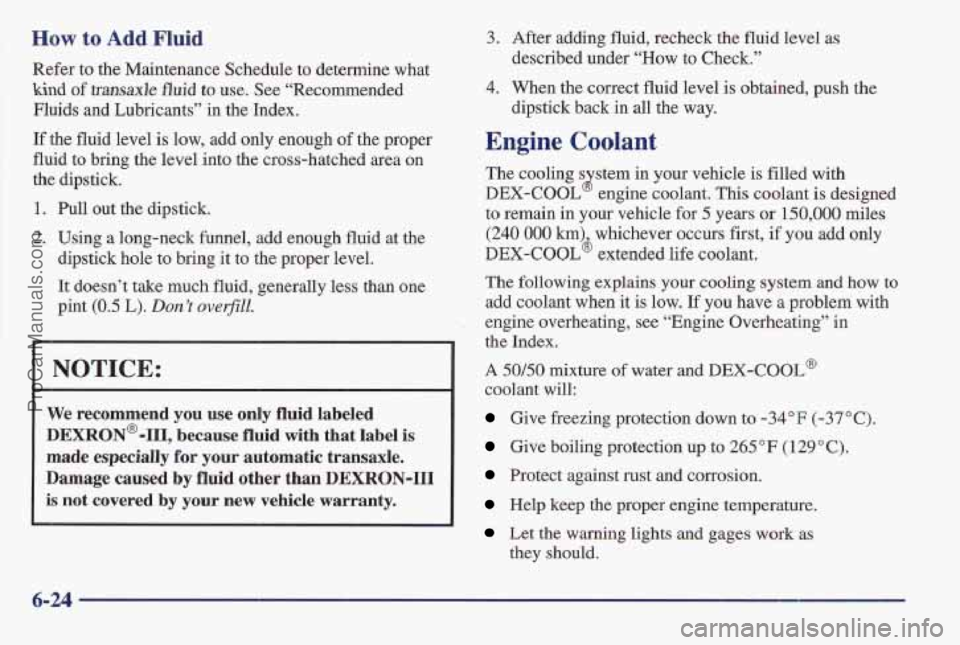
How to Add Fluid
Refer to the Maintenance Schedule to determine what
kind of transaxle fluid to use. See “Recommended
Fluids and Lubricants” in the Index.
If
the fluid level is low, add only enough of the proper
fluid to bring the level into the cross-hatched area on
the dipstick.
1. Pull out the dipstick.
2. Using a long-neck funnel, add enough fluid ,. @e
dipstick hole to bring it to’ the proper level.
It doesn’t take much fluid, generally less than one
pint
(0.5 L). Don’t overjU.
NOTICE:
We recommend you use only fluid labeled
DEXRON@-111, because fluid with that label i,s
made especially for your automatic transaxle.
Damage caused by fluid other than DEXRON-I11
is not covered by your new vehicle warranty.
3. After adding fluid, recheck the fluid level as
described under “How to Check.”
4. When the correct fluid level is obtained, push the
dipstick back in all the way.
Engine Coolant
The cooling s stem in your vehicle is filled with
DEX-COOL engine coolant. This coolant is designed
to remain in your vehicle for
5 years or 150,000 miles
(240 000 km) whichever occurs first, if you add only
DEX-COOL6 extended life coolant.
The following explains your cooling system and how to
add coolant when it is low. If you have ;e problem with
engine overheating, see “Engine Overheating” in
the
Index.
A 50J50 mixture of water and DEX-COOL@
coolant will:
Give freezing protection down to -34°F (-37°C).
Give boiling protection up to 2685 “F (129 O C).
Protect against rust and corrosion.
Help keep the proper engine temperature.
Llet the warning lights and gages work as
8
they should.
6-24
ProCarManuals.com
Page 278 of 405
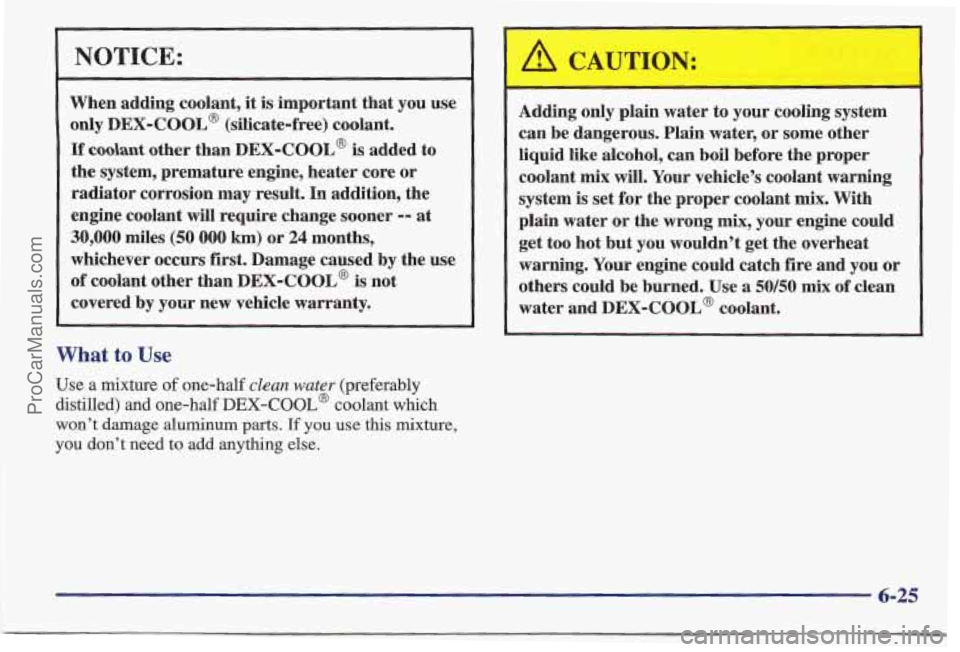
NOTICE:
When adding coolant, it is important that you use
only
DEX-COOL@ (silicate-free) coolant.
If coolant other than DEX-COOL@ is added to
the system, premature engine, heater core or
radiator corrosion may result.
In addition, the
engine coolant will require change sooner
-- at
30,000 miles (50 000 km) or 24 months,
whichever occurs first. Damage caused by the use
of coolant other than DEX-COOL@ is not
covered by your new vehicle warranty. Adding
only plain water to your cooling system
can be dangerous. Plain water, or some other
liquid like alcohol, can boil before the proper
coolant mix will. Your vehicle’s coolant warning
system is set for the proper coolant mix. With
plain water or the wrong mix, your engine could
get too hot but you wouldn’t get the overheat
warning. Your engine could catch fire and you or
others could be burned. Use a 50/50 mix of clean
water and DEX-COOL@ coolant.
What to Use
Use a mixture of one-half clean water (preferably
distilled) and one-half
DEX-COOL@ coolant which
won’t damage aluminum
parts. If you use this mixture,
you don’t need to add anything else.
6-25
ProCarManuals.com
Page 284 of 405
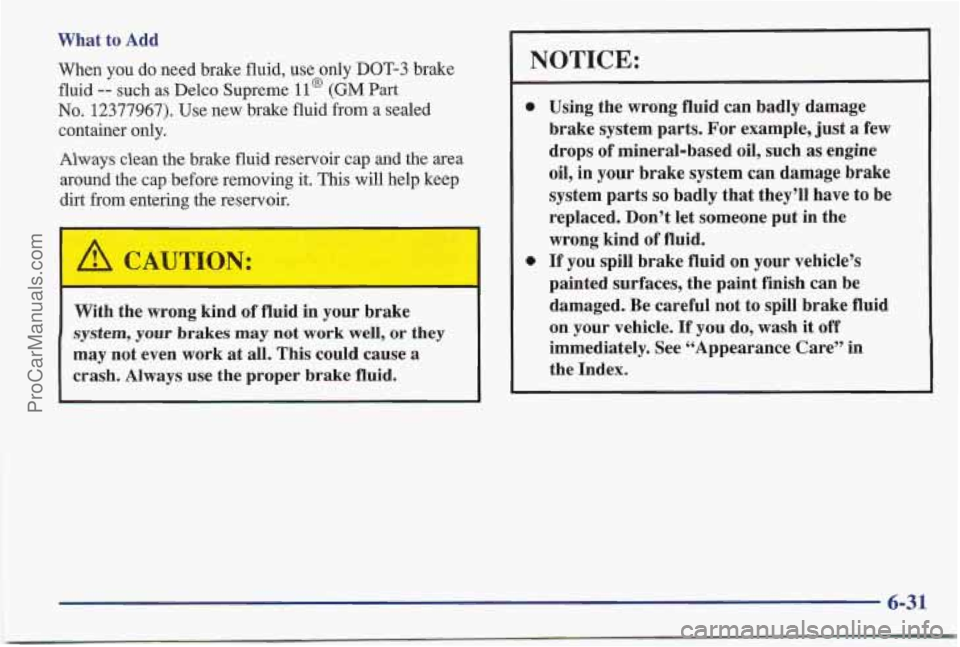
What to Add
When you do need brake fluid, use only
DOT-3 brake
fluid
-- such as Delco Supreme ll@ (GM Part
No. 12377967). Use new brake fluid from a sealed
container only.
Always clean the brake fluid reservoir cap and the area
around the
cap before removing it. This will help keep
dirt from entering the reservoir.
- - - -
A CAUTION:
With the wrong kind of fluid in your brake
system, your brakes may not work well, or they
may not even work at all. This could cause
a
crash. Always use the proper brake fluid.
NOTICE:
0
Using the wrong fluid can badly damage
brake system parts. For example, just
a few
drops of mineral-based oil, such
as engine
oil, in
your brake system can damage brake
system parts
so badly that they’ll have to be
replaced. Don’t let someone put in the
wrong kind of fluid.
If you spill brake fluid on your vehicle’s
painted surfaces, the paint finish can be
damaged. Be careful not to spill brake fluid
on your vehicle.
If you do, wash it off
immediately. See “Appearance Care” in
the Index.
ProCarManuals.com
Page 319 of 405
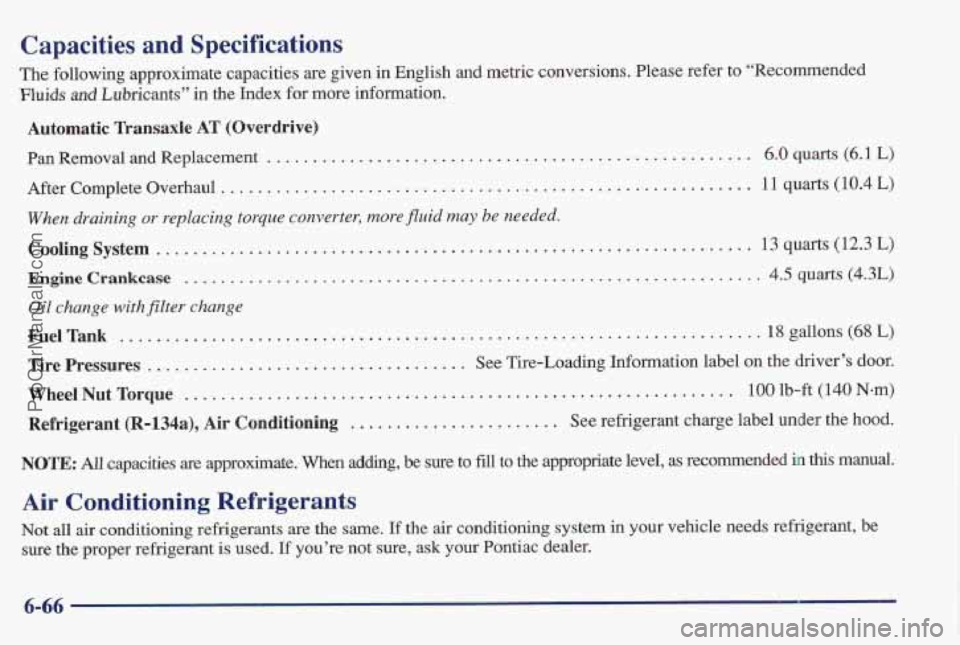
Capacities and Spc Ltions
The following approximate capacities are given in English and metric conversions. Please refer to “Recommended
Fluids and Lubricants’’ in the Index for more information.
Automatic Transaxle AT (Overdrive)
Pan Removal and Replacement ......... ........................................ 6.0 quarts (6.1 L)
After Complete Overhaul .......................................................... 11 quarts (10.4 L)
Cooling System ................................................................. 13 quarts (12.3 L)
Engine Crankcase ............................................................... 4.5 quarts (4.3L)
When draining or replacing torque conver,ter, more fluid may be needed.
.......
Oil change with filter change
FuelTank ........................... ................................ 18 gallons (68 L)
Tire Pressures ................................... See Tire-Loading Information label on the driver’s door.
Refrigerant (R=134a), Air Conditioning ....................... See refrigerant charge label under the hood.
WheelNutTorque ............................................................ 100 lb-ft (140 N-m)
NOTE: All capacities are approximate. When adding, be sure to fill to the appropriate level, as recommended in this manual.
Air Conditioning Refrigerants
Not all air conditioning refrigerants are the same. If the air conditioning system in your vehicle needs refrigerant, be
sure the proper refrigerant is used.
If you’re not sure, ask your Pontiac dealer.
6-66
ProCarManuals.com
Page 320 of 405
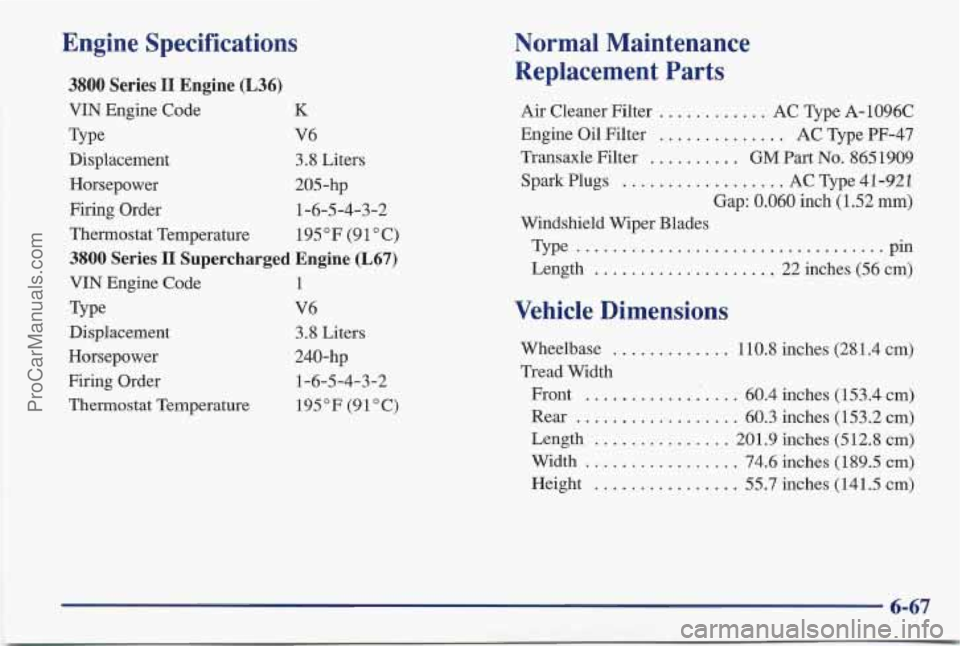
Engine Specifications
3800 Series I1 Engine (L36)
VIN Engine Code K
Type V6
Displacement
3.8 Liters
Horsepower 205-hp
Firing Order 1-6-5-4-3-2
Thermostat Temperature 195°F (91OC)
3800 Series I1 Supercharged Engine (L67)
VIN Engine Code 1
Type V6
Displacement 3.8
Liters
Horsepower 240-
hp
Firing Order 1-6-5-4-3-2
Thermostat Temperature 195°F (91OC)
Normal Maintenance
Replacement Parts
Air Cleaner Filter ............ AC Type A-1096C
Engine Oil Filter
.............. AC Type PF-47
Transaxle Filter
.......... GM Part No. 865 1909
Spark Plugs .................. AC Type 41-921
Gap:
0.060 inch (1.52 mm)
Windshield Wiper Blades
Type
..................................
Length .................... 22 inches (56 cm)
Pin
Vehicle Dimensions
Wheelbase ........... 110.8 inches (28 1.4 cm)
Tread Width Front
................. 60.4 inches (153.4 cm)
Rear
.................. 60.3 inches (153.2 cm)
Length
............... 201.9 inches (512.8 cm)
Height
.............. 55.7 inches (141.5 cm)
Width ........ + ........ 74.6 inches (1 89.5 cm)
6-67
ProCarManuals.com
Page 322 of 405
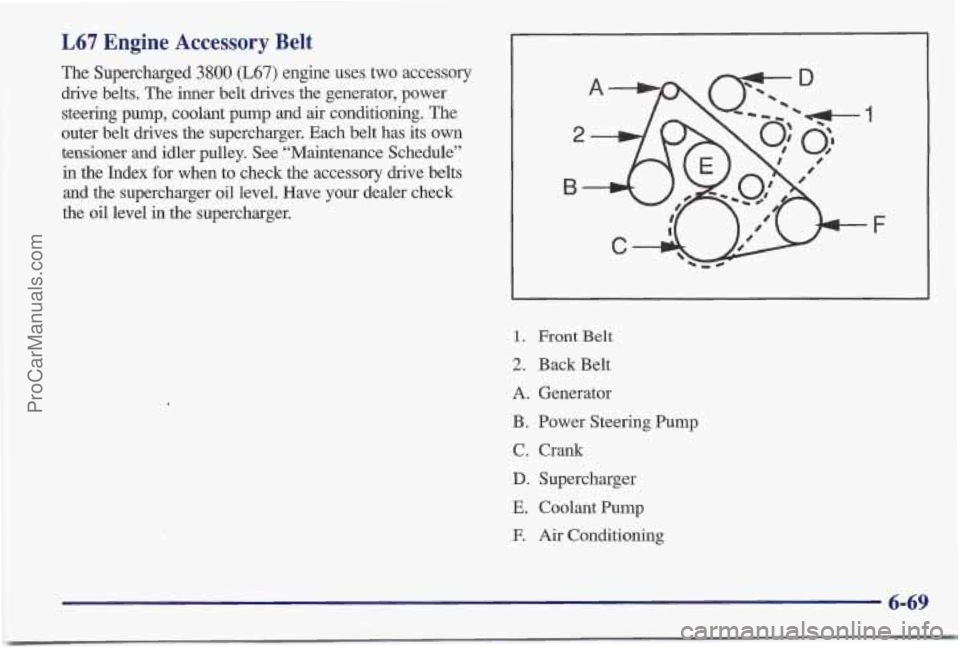
L67 Engine Accessory Belt
The Supercharged 3800 (L67) engine uses two accessory
drive belts. The inner belt drives the generator, power
steering pump, coolant pump
and air conditioning. The
outer belt drives the supercharger. Each belt has its own
temioner and idler pulley. See “Maintenance Schedule’’
in the Index for when to check the accessory drive belts
and the supercharger oil level. Have your dealer check
the
oil level in the supercharger.
F
1. Front Belt
2. Back Belt
A. Generator
B. Power Steering Pump
C. Crank
D. Supercharger
E. Coolant Pump
E Air Conditioning
6-69
ProCarManuals.com
Page 328 of 405
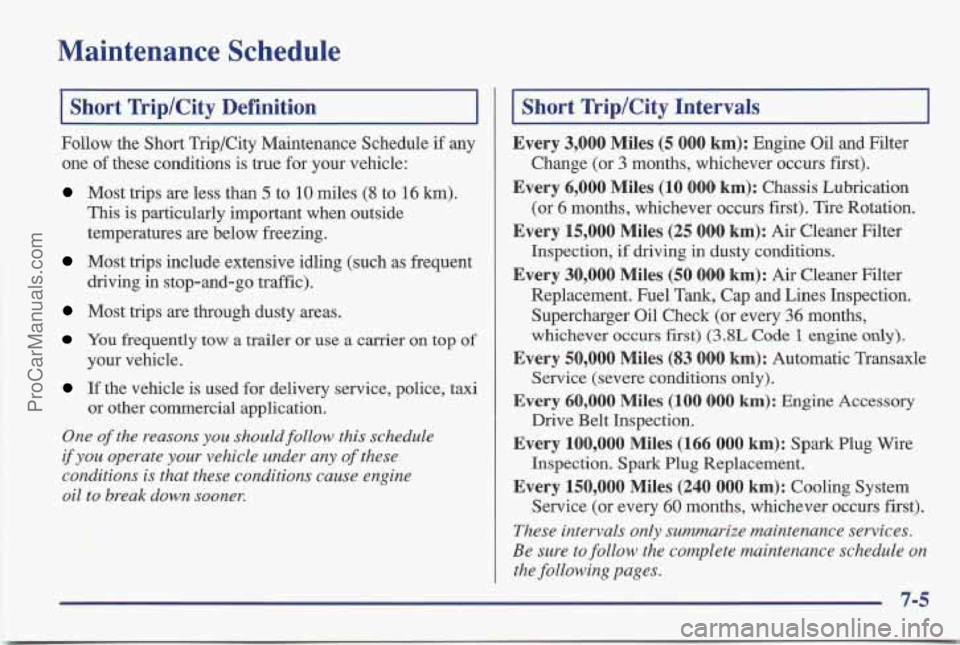
Maintenance Schedule
1 Short Trip/City Definition I
Follow the Short Trip/City Maintenance Schedule if any
one of these conditions is true for your vehicle:
Most trips are less than 5 to 10 miles (8 to 16 km).
This is particularly important when outside
temperatures are below freezing.
Most trips include extensive idling (such as frequent
driving in stop-and-go traffic).
Most trips are through dusty areas.
You frequently tow a trailer or use a carrier on top of
your vehicle.
If the vehicle is used for delivery service, police, taxi
or other commercial application.
One of the reasons you should follow this schedule
if you operate your vehicle under any of these
conditions is that these conditions cause engine
oil to break down sooner.
Short Trip/City Intervals
Every 3,000 Miles (5 000 km): Engine Oil and Filter
Change (or
3 months, whichever occurs first).
Every 6,000 Miles (10 000 km): Chassis Lubrication
(or
6 months, whichever occurs first). Tire Rotation.
Every 15,000 Miles (25 000 km): Air Cleaner Filter
Inspection, if driving in dusty conditions.
Every 30,000 Miles (50 000 km): Air Cleaner Filter
Replacement. Fuel Tank, Cap and Lines Inspection.
Supercharger Oil Check (or every
36 months,
whichever occurs first)
(3.8L Code 1 engine only).
Every 50,000 Miles (83 000 km): Automatic Transaxle
Service (severe conditions only).
Every 60,000 Miles (100 000 km): Engine Accessory
Drive Belt Inspection.
Every 100,000 Miles (166 000 km): Spark Plug Wire
Inspection. Spark Plug Replacement.
Every 150,000 Miles (240 000 km): Cooling System
Service (or every
60 months, whichever occurs first).
These intervals only summarize maintenance services.
Be sure to
follow the complete maintenance schedule on
the following pages.
-- 7-5
ProCarManuals.com
Page 329 of 405
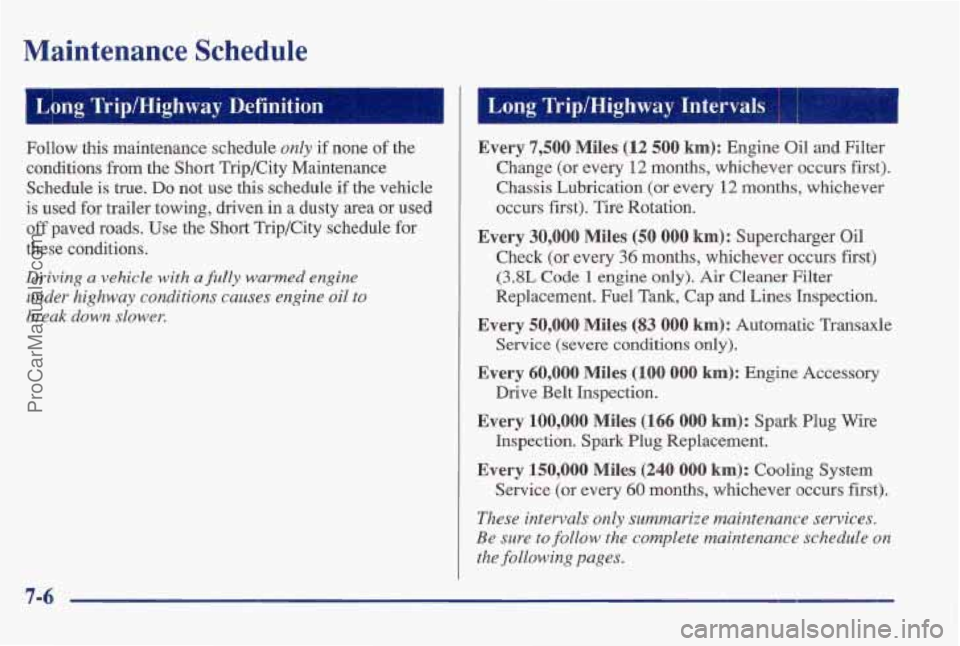
Maintenance Schedule
Follow this maintenance schedule only if none of the
conditions
from the Short Trip/City Maintenance
Schedule is true.
Do not use this schedule if the vehicle
is used for trailer towing, driven in a dusty area or used
off
paved roads. Use the Short Trip/City schedule for
these conditions.
Driving a vehicle with a fdy warmed engine
under highway conditions causes engine
oil to
break down slower.
Every 7,500 Miles (12 500 km): Engine Oil and Filter
Change (or every
12 months, whichever occurs first).
Chassis Lubrication (or every
12 months, whichever
occurs first). Tire Rotation.
Every 30,000 Miles (50 000 km): Supercharger Oil
Check (or every
36 months, whichever occurs first)
(3.8L Code 1 engine only). Air Cleaner Filter
Replacement. Fuel Tank, Cap and Lines Inspection.
Every 50,000 Miles (83 000 km): Automatic Transaxle
Service (severe conditions only).
Every 60,000 Miles (100 0100 km): Engine Accessory
Every 100,000 Miles (166 000 km): Spark Plug Wire
Every 150,0001 Miles (240 000 km): Cooling System
Drive Belt Inspection.
Inspection.
Spark Plug Replacement.
Service (or every
60 months, whichever occurs first).
These intervals only summarize maintenance services.
Be sure
to follow the complete maintenance schedule on
the following
pages.
7-6
ProCarManuals.com
Page 331 of 405
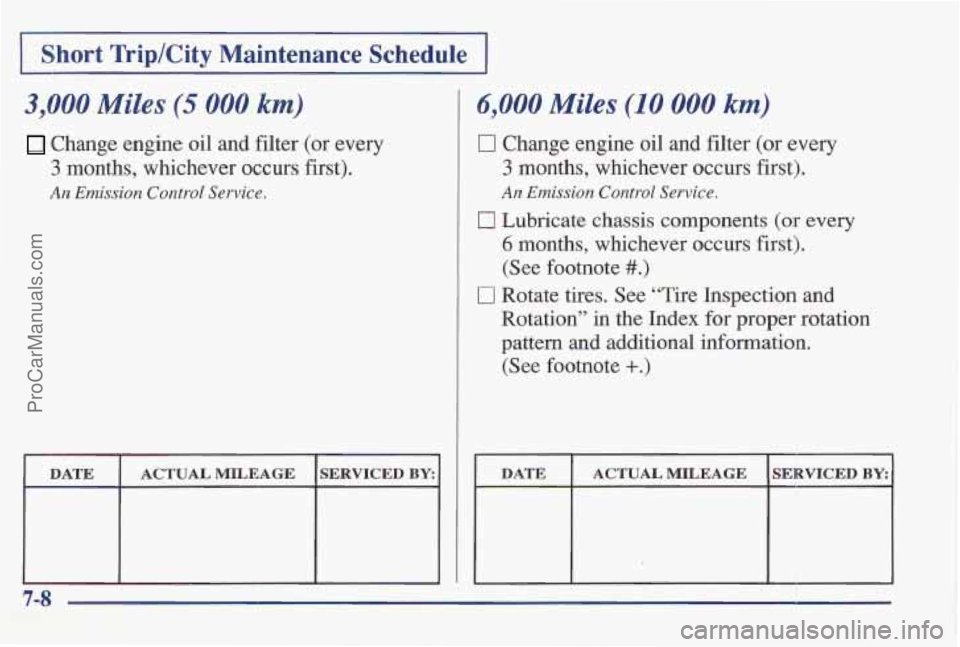
I Short Trip/City Maintenan’ce Schedule I
3,000 Miles (5 000 km)
Change engine oil and filter (or every
3 months, whichever occurs first).
An Emission Control Service.
DATE SERVICED BY: ACTUAL MILEAGE
6,000 Miles (10 000 km)
0 Change engine oil and filter (or every
3 months, whichever occurs first).
An Emission Control Service.
0 Lubricate chassis components (or every
6 months, whichever occurs first).
(See footnote
#.)
0 Rotate tires. See “Tire Inspection and
Rotation” in the Index for proper rotation
pattern and additional information.
(See footnote
+.)
DATE ACTUAL MILEAGE SERVICED BY:
7-8
ProCarManuals.com